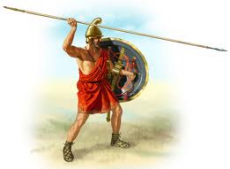
There were several great polis (cities) in Ancient Greece and we have already learnt briefly about Sparta, but the largest and most enduring is Athens, the capital city of modern day Greece. Athens' History spans back some 3,400 years and has produced some of the world's greatest philosophers including Plato and Aristotle as well as the earliest form of Democracy through Cleisthenes. Though the name of the city in Greek has changed several times over the years Athens was linked from its roots with Greek Goddess Athena. Although some Historians argue that Athens' name originates from the word flower in Greek (ἄνθος) and that it is the flowering city as it grew rapidly and vastly with help of its neighbouring city port of Piraeus to become the Metropolis that we know it as. Whatever the origins of its name Athens is often called the Great City or Capital by Greeks and even in Ancient Greece when the neighbouring cities fought amongst one another so regularly it was still a great and feared force and despite narrowly losing the Peloponessian War to Sparta grew to supremacy in the end over its neighbouring states.
With Athens' greater attention to the arts and culture they were able to produce greater thinkers and better strategies of governing. Although Sparta's warriors were virtually unstoppable they could not surpass the walls of Athens and with their helot slaves running their city they left little allowance for intellectual men who were considered weak and not true Spartans. The governing system of Athens led them on to prosperity when their rival Greek states began to crumble through slave revolts and a lack of sustainability. This is not to say however that Athens had no military, indeed their military force was very strong and they had heavily armoured Hoplites like most of the powerful Greek Cities at the time. In fact a great innovation that Athenian warfare saw was the introduction of Peltasts, lightly armoured with javelins and a shield they could harass the enemy from afar with skirmish tactics and their javelins could penetrate the strong Greek armour. In fact under Athenian General Ithicrates they were able to defeat an entire Spartan Mora* without taking a single casualty!

Athens is known to have been inhabited for some 7000 years meaning that there were people living there before even the Great Pyramid at Giza was built by the Egyptians! The Great Acropolis at Athens was once a Mycenean age Castle which dates it back to Dark Age Greece (so called because we have little to no information on it) and the legendary era of the fall of the city of Troy (we still do not know how much of this story is true). Apart from its early foundings and security (the great cyclopean walls) Athens' main advantage over rivals like Thebes and Sparta was its location close to the sea as it could flourish in trade as a port city. This also allowed for a powerful navy which was one of their key advantages over Sparta during civil wars and although the Spartans are known for heroically holding Xerxes' Persian army at the Battle of Thermopylae for some days despite their great numerical disadvantage it was the Athenian military that defeated Darius' army first (Xerxes' father) and pushed back Xerxes during the Greco-Persian wars. Although all of the Ancient Greek states had their various strengths Athens had a perfect combination of all of them. It was the jack of all trades of Ancient cities.
Athens was conquered by the Northern Hellenic Macedonians under King Phillip II (father of Alexander the Great) and lost its great indepedance and power for some time before it was freed by the Romans when they conquered Greece some years later as they so admired the great brains of Athens and its revolutionary ideal of democracy. When we study the Romans we'll see how they adopted much from the formerly flourishing Greeks and adapted it to suit their own needs. Greatest of all the Greek Cities and home to the Olympic Games, Athens is a pilgrimage site of History and the great Acropolis and Panthenon still stand in a reasonable condition today, attracting millions of tourists from around the world to witness the remnants of a great city of the Ancient World. The first image shows the great Acropolis as it is today and the second shows a peltast, expert at defeating strongly armoured units from a distance.

0 Comment:
Be the first one to comment on this article.